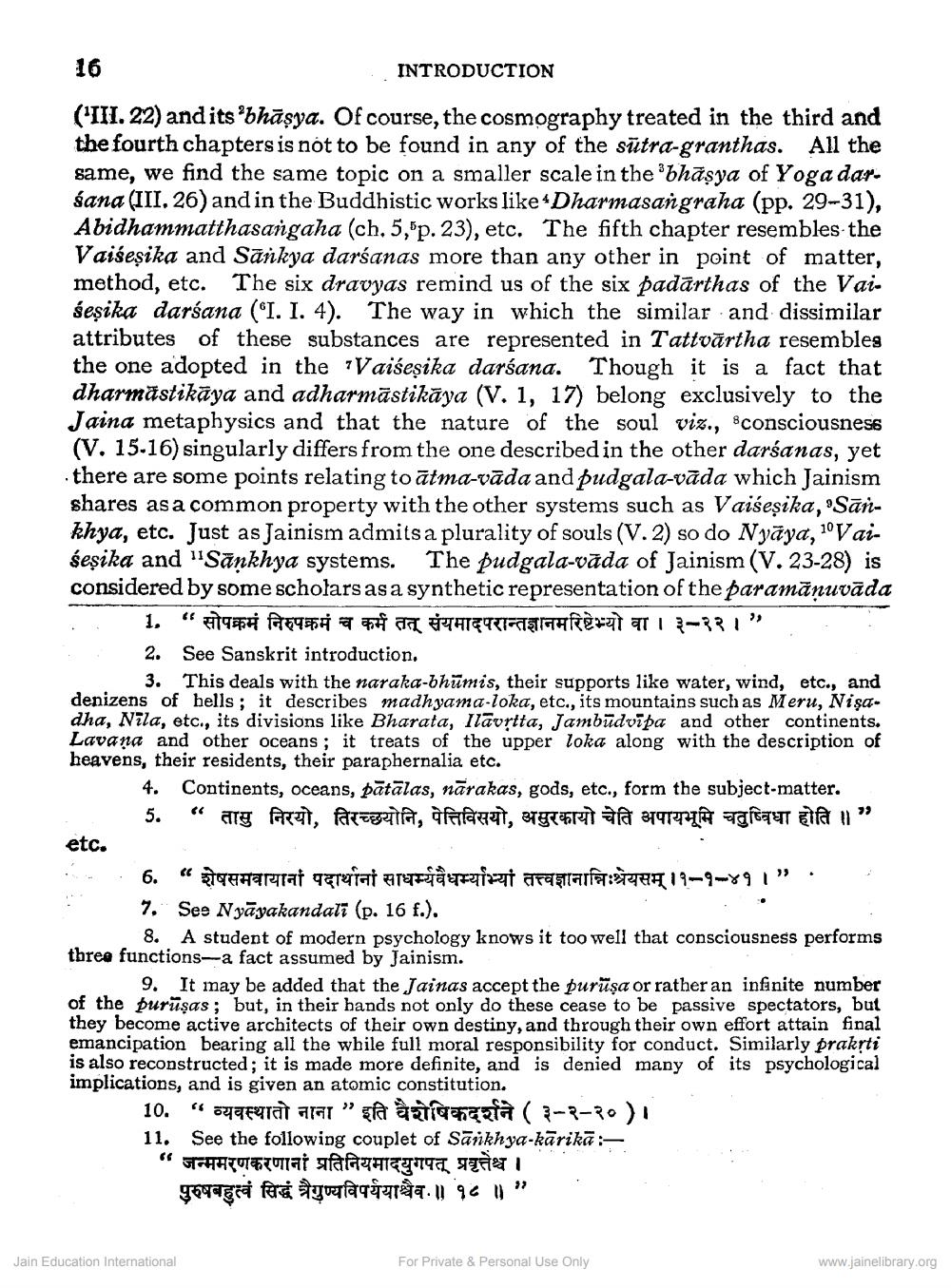________________
16
INTRODUCTION ('III. 22) and its 'bhāşya. Of course, the cosmography treated in the third and the fourth chapters is not to be found in any of the sutra-granthas. All the same, we find the same topic on a smaller scale in the bhāsya of Yoga da sana (III. 26) and in the Buddhistic works like Dharmasangraha (pp. 29-31), Abidhammatthasangaha (ch.5, p. 23), etc. The fifth chapter resembles the Vaiseșika and Sänkya darśanas more than any other in point of matter, method, etc. The six dravyas remind us of the six padarthas of the Vai. seșika darśana (I. I. 4). The way in which the similar and dissimilar attributes of these substances are represented in Tattvārtha resembles the one adopted in the Vaiseșika darśana. Though it is a fact that dharmastikāya and adharmāstikāya (V. 1, 17) belong exclusively to the Jaina metaphysics and that the nature of the soul viz., sconsciousness (V. 15-16) singularly differs from the one described in the other darśanas, yet there are some points relating to ātma-vāda and pudgala-vāda which Jainism shares as a common property with the other systems such as Vaišeşika, Sankhya, etc. Just as Jainism admits a plurality of souls (V.2) so do Nyāya, 'Vaiseșika and 'Sankhya systems. The pudgala-vāda of Jainism (V. 23-28) is considered by some scholars as a synthetic representation of the paramānuvāda . 1. " 99 F695897 TATETT Hexa at I 1-331"
2. See Sanskrit introduction.
3. This deals with the naraka-bhūmis, their supports like water, wind, etc., and denizens of hells; it describes madhyama-loka, etc., its mountains such as Meru, Nişa. dha, Nila, etc., its divisions like Bharata, Ilavrtta, Jambūdvipa and other continents. Lavana and other oceans; it treats of the upper loka along with the description of heavens, their residents, their paraphernalia etc.
4. Continents, oceans, pātālas, nārakas, gods, etc., form the subject matter.
5. " aty Pal, Razala, affiatatt, sport a TTA CITET E ! " etc.
6. “ T arrat qerautat ateriapizzi arafaifaTa 19-9-891". 7. See Nyāyakandali (p. 16 f.).
8. A student of modern psychology knows it too well that consciousness performs threa functions--a fact assumed by Jainism.
9. It may be added that the Jainas accept the puruṣa or rather an infinite number of the purūsas; but, in their hands not only do these cease to be passive spectators, but they become active architects of their own destiny, and through their own effort attain final emancipation bearing all the while full moral responsibility for conduct. Similarly prakrti is also reconstructed; it is made more definite, and is denied many of its psychological implications, and is given an atomic constitution.
10. “ 74979ra art" sa atiqangala (3-2-20) 11. See the following couplet of sankhya-kārikā :
जन्ममरणकरणानां प्रतिनियमादयुगपत् प्रवृत्तेश्च । 96996ra fars gula | 9C U " . .
Jain Education International
For Private & Personal Use Only
www.jainelibrary.org




